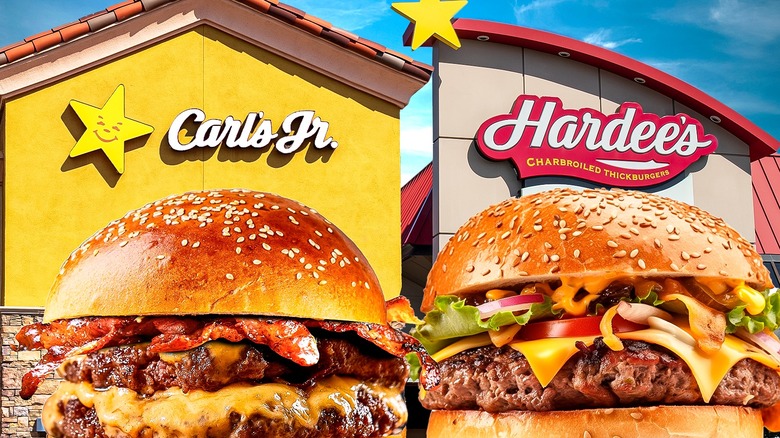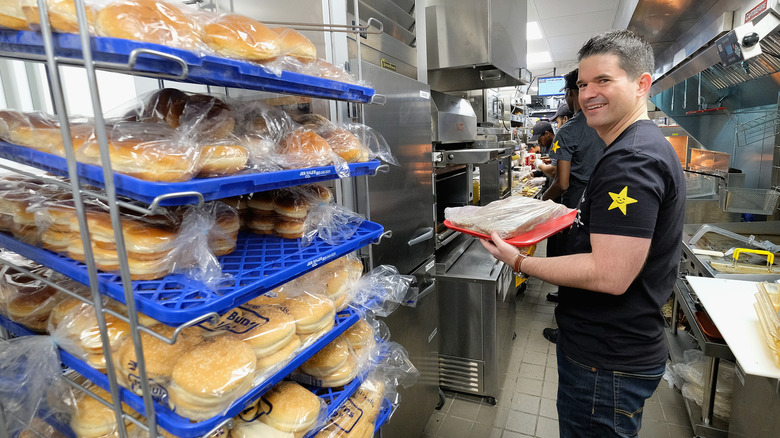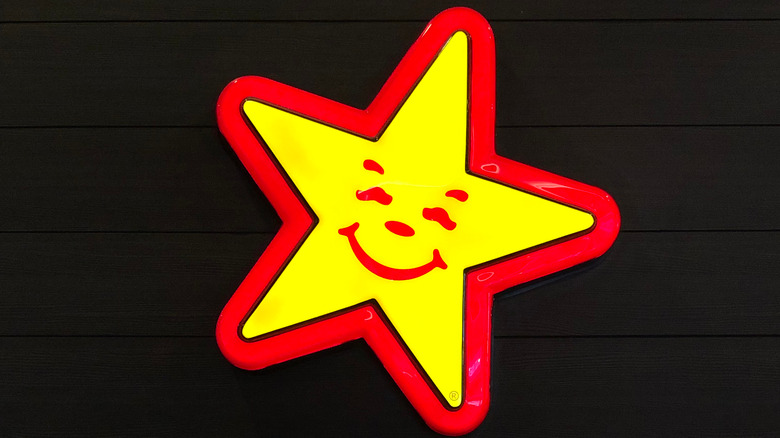Is There A Difference Between Carl's Jr And Hardee's?
In many ways, the story of Carl's Jr. and Hardee's exemplifies the shifting dynamics we've seen in the American economy over the past 100 years. Cutting a diagonal slash across the face of the nation from the Idaho panhandle to the eastern edge of Texas is the friendly divide that separates the two fast food chains. Out west, you have Carl's Jr. sporting a dated but charming Happy Star logo over its name. Heading back east will have you spotting the same smiling star logo with the same color scheme and font, only now it's called Hardee's.
With so little interaction between the two restaurants, there's little reason for most of us to be aware of the difference unless you travel across the country regularly. Unaware newlyweds shuttling to a new job lined up three states over may not even register the change — like an episode of "The Twilight Zone" where everything feels exactly the same, only there's a sneaking suspicion that something is off.
While the two fast food companies share a nearly identical logo and are both owned by the same parent company, CKE Restaurants, the two don't share an identical menu (though differences at this point are minor). Until recently, both even ran identical advertisements, just with the names changed. That's no longer happening and, while the two chains aren't normally considered industry leaders, the new direction could give us insight into what the future of American marketing might look like.
When the burgers flowed like wine
Carl's Jr. was the first of the two restaurants to start when its founder, Carl Karcher, opened a hot dog stand in downtown LA in 1941. In a paltry five years' time, Karcher had turned his hot dog stand into a brick-and-mortar business in Anaheim called Carl's Drive-In Barbeque, which offered hamburgers as well as hot dogs. Hamburgers were becoming the symbol of classic American food, so when Karcher was looking to compete with the local McDonald's in 1956, he opened a hamburger-specific joint called Carl's Jr.
Four years later, in 1960, Wilber Hardee opened the windows on his first restaurant on the other side of the country in Greenville, North Carolina. Interestingly enough, Hardee was joined by two business partners and then voluntarily left the business shortly after it had begun. Despite the loss of its founder, Hardee's expanded aggressively over the coming years by focusing on areas that other fast food chains had not yet reached. In ten years, there were 200 locations, and by the 1990s, there were nearly 2,500.
Carl Karcher incorporated his business into Carl Karcher Enterprises (CKE), which is the parent company of both restaurants today. Seeking to expand east, CKE bought Hardee's out in 1997 for $327 million. The two restaurants became something like non-identical twins. Hardee's kept its name and its menu but, while each was allowed to be its own brand, there were some changes on the horizon.
A modern mish-mash
At the time of the merger, there were only 676 Carl's Jr. locations, which paled in comparison to the 3,152 Hardee's sprawled across the Midwest and South. Despite the strength in numbers, Carl Karcher was the new owner, and Hardee's would adopt the Carl's Jr. Happy Star logo, which has been in use since the first Carl's Jr. opened in 1956. Menu items from Carl's Jr. slowly trickled their way onto the Hardee's menu (and the two routinely launch the same new menu items these days), and by all accounts, the two companies were becoming more and more the mirror image of each other.
Despite all the new clothes, Hardee's retained its rural Midwestern sensibilities — Hardee's enjoyed Americana and a game of cornhole. Carl's Jr. liked skateboarding and thought Warped Tour was rad. These differences haven't really gone away and there's no reason to think that's going to change any time soon. Hardee's got its foot in the door by focusing on small rural towns not being served by other fast food chains and those locations remain the same. Carl's Jr., on the other hand, is located in major urban areas on the West Coast and in the Southwest. After a string of Hardee's locations closed down, the company has come to understand that what these two regions want is not the same thing and that by advertising to everyone it was advertising to no one. The new advertising campaigns have been a big success, which could point away from national branding to refocus on regional audiences.


